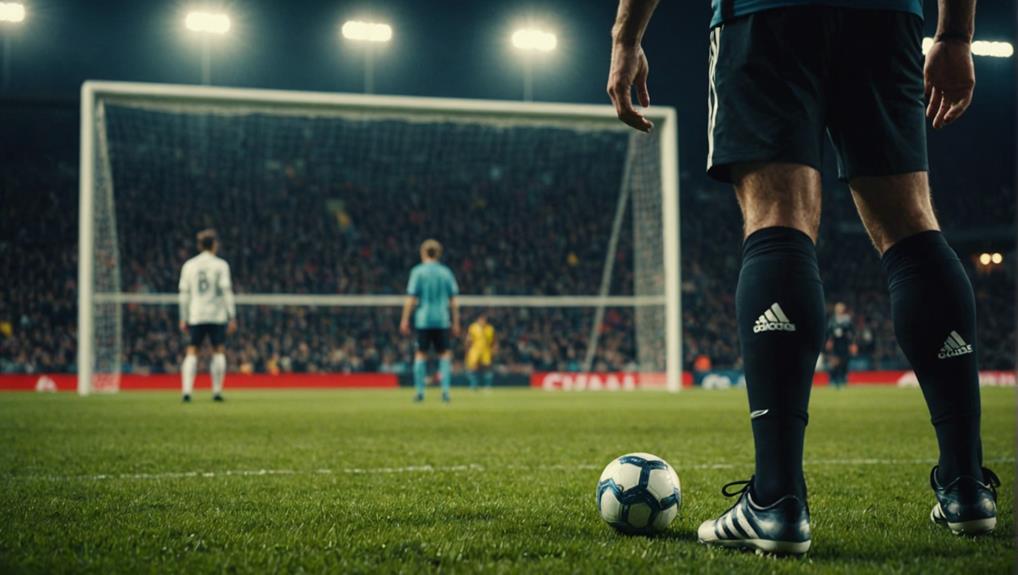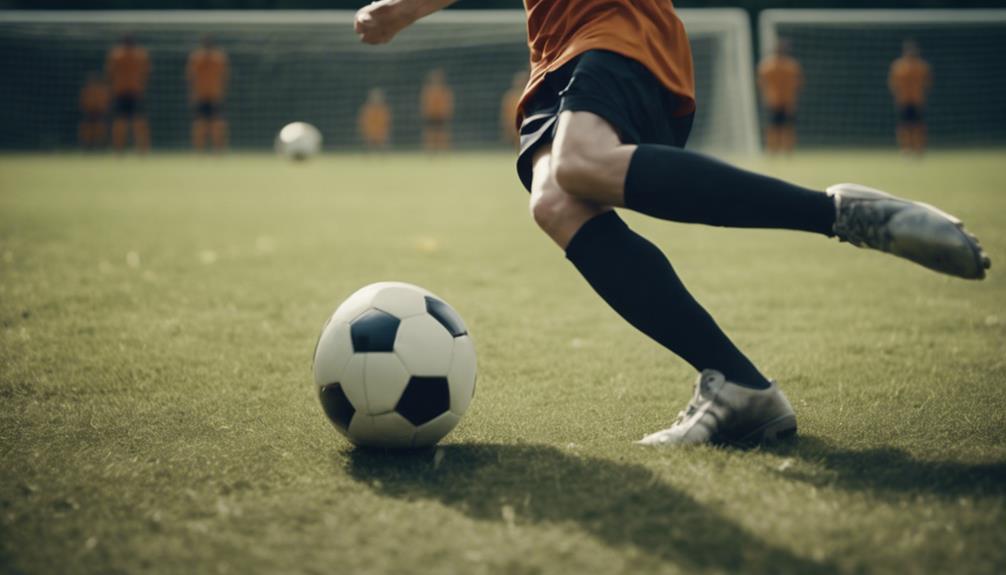
Mastering Soccer Penalty Kicks: Step-by-Step Guide
April 30, 2024Position the ball precisely on the penalty marker 12 yards away. Choose a good grass spot for a clean strike. Align your non-kicking foot and focus on the goal before shooting. Maintain balance and power with proper weight distribution. Visualize success and stay focused on your target. Mastering soccer penalty kicks hinges on these steps.
Proper Ball Placement
For essential execution of a penalty kick, position the ball precisely on the penalty marker 12 yards away from the goal. This vital step in proper ball placement sets the stage for success.
By practicing taking penalty kicks from this standard spot, you increase your chances of scoring. Remember, consistency is key.
Placing the ball on a good piece of grass guarantees a clean strike, giving you the best opportunity to outwit the goalkeeper.
Additionally, consider your dominant foot when positioning the ball slightly to the left or right to create the best angle for your shot.
Correct Body Positioning
Position your body correctly by aligning your non-kicking foot with the ball for balance and accuracy.
Guarantee that your weight is evenly distributed to maintain a relaxed and powerful posture.
Keep your focus on the target spot to guide your shot effectively.
Feet Alignment Crucial
Guarantee ideal body positioning by aligning your non-kicking foot with the ball when preparing for a penalty kick. This alignment sets the foundation for a successful kick.
As you approach the ball, make sure that your non-kicking foot is in line with the ball, pointing towards your target. This positioning helps you maintain balance and control during the kick.
By aligning your non-kicking foot correctly, you create a stable base from which to strike the ball with power and accuracy. This alignment also aids in generating the necessary force to propel the ball towards the goal.
Focus on this fundamental aspect to improve your penalty kick technique and increase your chances of scoring.
Balance Weight Evenly
To maintain balance and stability during a penalty kick, make sure that your weight is evenly distributed on both feet. Proper weight distribution is essential as it helps you stay grounded and poised behind the ball.
By evenly balancing your weight, you set yourself up for a more controlled and powerful strike. This technique is fundamental in executing an accurate shot. Aligning your body correctly not only enhances your shot's precision but also aids in generating the necessary power.
Make sure your body is positioned correctly, with your weight evenly distributed, to maximize your chances of a successful penalty kick. Remember, mastering the balance of weight on both feet is a key aspect of penalty kick techniques.
Eyes on Target
Make sure that your eyes are locked onto the target spot on the goal to enhance accuracy and focus as you prepare for the penalty kick. By maintaining eye contact with the scoring area, you increase your chances of placing the ball where you intend.
Additionally, looking at the keeper can help you assess their position and potentially identify any weaknesses in their stance. Correct body positioning involves aligning your non-kicking foot with the ball for stability and balance.
Keeping your head up allows you to visualize the target area and the goalkeeper's position. Ensure your kicking foot is firm yet not tense to generate the power and accuracy needed to score.
Mental Preparation Techniques
To mentally prepare for penalty kicks, focus on visualizing success. Practice breathing exercises for concentration. Use positive self-talk strategies.
Visualize Success Mindset
When preparing mentally for penalty kicks in soccer, envisioning the ball hitting the back of the net can greatly enhance your performance.
Visualizing success mindset and employing mental preparation techniques are key to boosting confidence and reducing anxiety during pivotal moments.
By mentally rehearsing the perfect kick and focusing on the target spot, you can improve accuracy and shot placement.
This practice not only enhances your chances of scoring but also helps in winning the mental battle of penalty kicks.
Remember, maintaining a positive visualization of success is essential for your performance on the field.
Breathing Exercises for Focus
Engage in deep breathing exercises to enhance your focus and mental preparedness before stepping up for a penalty kick in soccer. Controlled breathing techniques can help reduce anxiety and improve mental clarity, vital for scoring with confidence during pivotal moments on the field.
By practicing penalty kicks regularly while incorporating proper breathing patterns, you can optimize oxygen flow to your brain, aiding in concentration and decision-making. Utilizing breathing exercises will assist you in staying present, composed, and confident when facing the goalkeeper.
Consistent practice of these techniques will train your mind to maintain a steady state of readiness and concentration, ultimately improving your performance during critical moments in a match.
- Reduce anxiety and enhance mental clarity
- Optimize oxygen flow to the brain
- Maintain a steady state of readiness
Positive Self-Talk Strategies
Before executing a penalty kick in soccer, implement positive self-talk strategies to boost your confidence and mental resilience in high-pressure situations. By harnessing the power behind affirmations and encouraging statements, you can feel confident and focused when it matters most.
Research indicates that positive self-talk not only reduces anxiety but also enhances performance during critical moments. By reframing any negative thoughts into positive ones, you can improve your overall mindset and approach to penalty kicks.
Consistent practice of positive self-talk can lead to a more resilient and self-assured demeanor when facing these high-stakes situations. Remember, the way you talk to yourself can have a significant impact on your performance on the field.
Visualizing the Shot
To enhance your penalty kick accuracy and boost your confidence, visualizing the shot is an essential step in your preparation. By mentally rehearsing your penalty kick, you can effectively improve your performance under pressure.
Here are some key points to contemplate when visualizing the shot:
- Utilize visualization techniques: Engage your senses to vividly imagine the entire process of taking the penalty kick, from approaching the ball to striking it into the net.
- Practice mental rehearsal: Picture yourself successfully executing the penalty kick multiple times in your mind to build confidence and familiarity with the process.
- Imagine the desired outcome: Visualize the ball hitting the back of the net with precision, reinforcing positive outcomes and boosting your belief in your ability to score.
Developing Consistent Technique

To achieve consistent technique in soccer penalty kicks, focus on refining your foot placement and striking technique for best accuracy and power.
When taking penalty kicks, make sure your foot is placed correctly – try using the instep of your foot slightly above the center of the ball to maintain control and power. This foot placement helps in creating a slight topspin on the ball, causing a dipping effect that can enhance shot accuracy.
Additionally, maintaining a locked ankle and following through with your kick is essential for a clean and powerful shot execution. Remember, mental focus and visualization are key components in developing a consistent penalty kick technique.
Understanding Goalkeeper Cues
Studying the goalkeeper's positioning and movements provides valuable insights into identifying patterns and cues that can inform your decision-making during penalty kicks. By analyzing the goalkeeper's tendencies in saving penalty kicks, you can gain a strategic advantage. Look for cues such as body language, positioning on the goal line, and past behaviors to anticipate their actions. Using these insights, you can decide where to place the ball, which greatly increases your chances of scoring.
Observing the goalkeeper's body language can give clues about their intentions.
Noticing how far the goalkeeper stands from one goal post can help you choose your shot placement.
Remembering past encounters with the goalkeeper can reveal patterns in their reactions to penalty kicks.
Utilizing these goalkeeper cues effectively can give you an edge and enhance your ability to outwit the goalkeeper, ultimately improving your success rate when taking penalty kicks.
Handling Pressure Situations

When facing pressure situations during penalty kicks, practicing mental strategies is essential for maintaining focus and composure. To handle the intensity of the moment, it's vital to simulate pressure scenarios during practice. By doing this, you can build confidence and composure, preparing yourself for the real deal.
Deep breathing techniques can also be incredibly beneficial in helping you stay calm and focused when the pressure is on. Visualizing successful penalty kicks beforehand can mentally prepare you for the high-pressure situation, increasing your chances of success.
Implementing pre-shot routines can give you a sense of control and establish a routine that you can rely on when the stakes are high. Additionally, reviewing past successful experiences can remind you of your ability to perform under pressure, boosting your confidence when stepping up to take that crucial penalty kick.
Post-Kick Analysis and Adjustment
After successfully executing a penalty kick, your next step involves analyzing the goalkeeper's movements and positioning to gain insights for future kicks. It's essential to assess the post-kick scenario to understand both your performance and the goalkeeper's reactions.
Here are key steps to ponder:
- Analyze Patterns: Look for recurring patterns in the goalkeeper's movements or positioning that you can exploit in future kicks.
- Evaluate Your Technique: Reflect on your shot placement and technique to identify areas for improvement and refine your skills.
- Adjust Strategies: Based on the outcomes of your analysis, adapt and adjust your future penalty kick strategies to increase your chances of scoring.
Post-kick analysis is a valuable tool that can help you enhance your performance in pressure situations. Consider incorporating these insights into your training sessions to continuously improve and refine your penalty kick abilities. By learning from each kick, you can refine your strategies and increase your chances of success in future encounters.
Conclusion
So, next time you step up to take that vital penalty kick, remember to keep your cool and trust in your training. By mastering the art of penalty kicks, you'll be able to rise to the occasion and deliver when it counts.
Just like a well-oiled machine, with practice and focus, you can become a lethal weapon on the field.
So go out there and own that penalty spot like it's your own personal stage.


